Everyone keeps raving about the high ROI of email marketing. But you feel tired even thinking about building an email list. That’s where list management software can help.
A reliable list management tool saves you a lot of hassle about building and growing an email list.
In this blog, we’ll share the best mailing list management software you should try if you’re just beginning.
What is Email List Management Software?
Email list management software helps you maintain your list of subscribers from a single dashboard. It helps capture emails and keeps the list updated.
Email list management programs also save time segmenting your subscribers based on behavior, demographics, and engagement. It ensures better deliverability, reduces bounce rates, and boosts customer engagement.
Key Features for Mailing List Management Software
Modern email list management software providers offer a range of features designed to streamline and improve your email marketing efforts. They offer tools and features that help you organize your target audience quickly.
Here are the key features you should look for in an email list management software:
- Segmentation. Divide your email list into targeted groups based on behavior, demographics, and engagement to send more relevant messages;
- Automation. Automatically add, update, and remove contacts, saving time and reducing manual effort. Plus, kick off automated campaigns based on behavior/online activity;
- Personalization. Customize email content for individual subscribers to create a more engaging experience;
- Analytics. Track and measure the performance of your email campaigns with detailed metrics and reports;
- Compliance. Ensure your email marketing practices adhere to regulations like GDPR and CAN-SPAM to avoid legal issues by providing double opt-in signups;
- Integrations. Seamlessly connect with other marketing tools and platforms for a cohesive marketing strategy;
- Deliverability tools. Monitor and improve email deliverability rates to ensure your messages reach inboxes, not spam folders;
- Subscriber management. Easily manage subscriber preferences, opt-ins, and opt-outs to maintain a healthy email list.
11 Best Mailing List Management Software
When exploring the market for mailing list management software for your digital marketing efforts, consider the following options:
- Sender
- MailChimp
- Constant Contact
- ActiveCampaign
- OptinMonster
- HubSpot
- FluentCRM
- Listserv
- Brevo
- phpList
- SendGrid
Each comes with many useful features to help you scale quickly. Let’s check them out.
#1. Sender — Best Solution for Email List Management
Sender simplifies email list management with its advanced contact system. With smart segmentation, marketing automation, and list management tools, you’ll save time handling even the largest lists.
Best for
- Startups;
- Ecommerce stores;
- Service-based companies.

Create custom segments that match your strategy, then schedule personalized emails or launch automated drip marketing campaigns based on user behavior.
The interface is intuitive, and with live chat support responding in under a minute, you’ll be up and running fast—even if you’re new to email marketing.
But don’t let the simplicity fool you.
Sender also offers advanced features like multi-group tagging and segmentation rules, letting you easily automate tasks based on specific actions or conditions.
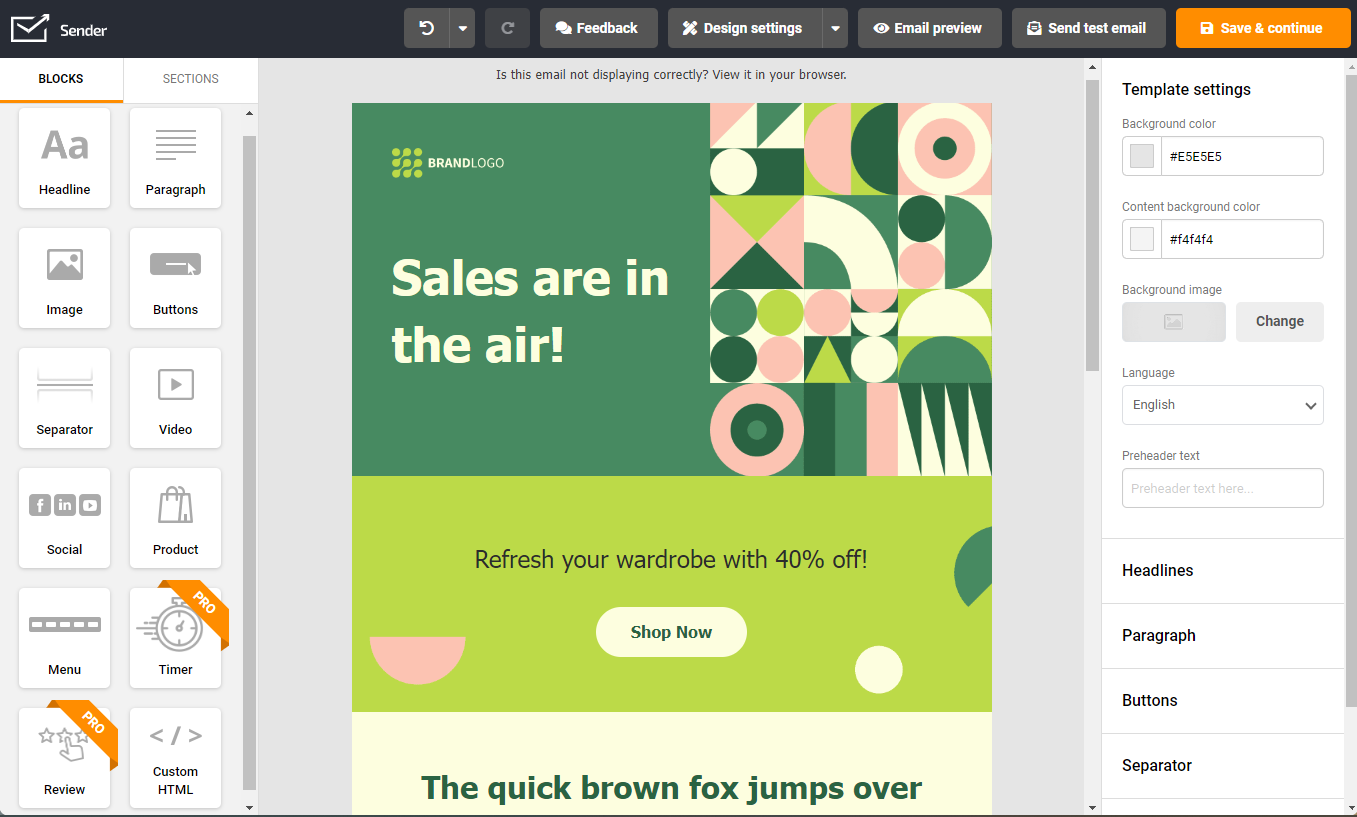
Key Features
- Advanced segmentation based on behavior, demographics, or conditions;
- Popup and form builder with ready-to-use templates;
- Unlimited custom fields to tailor list management to your needs;
- Behavioral marketing tools to track activity and send targeted emails;
- Automated filtering to optimize engagement.
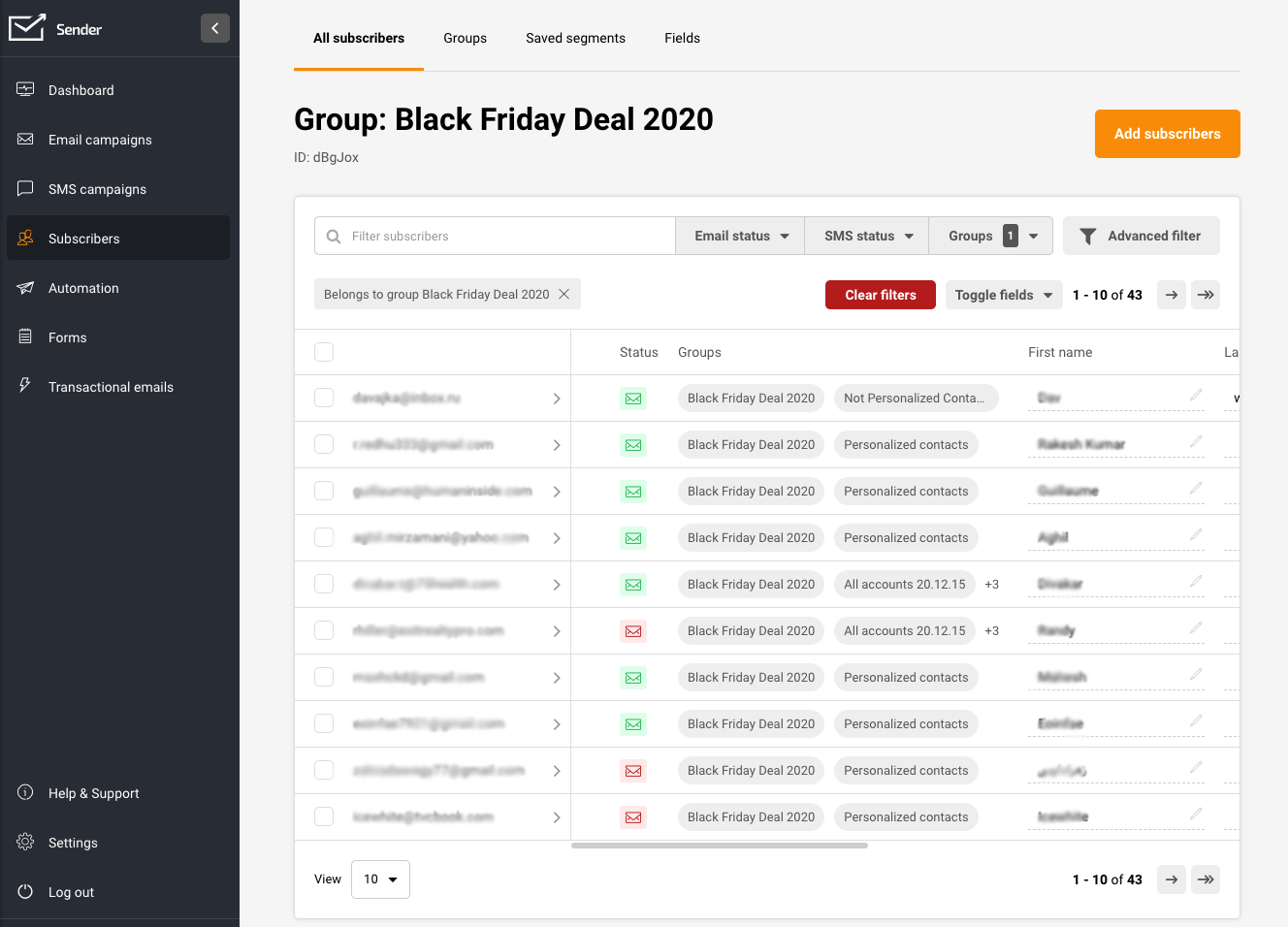
Pros & Cons
Sender offers a forever-free plan, so you can try it without commitments. It also has full-suite omnichannel automation capabilities and other advantages.
| Pros | Cons |
| Easy to set up and use | Limited signup form templates |
| Advanced behavioral marketing features | No landing page builder (yet) |
| Automated lead nurturing through email & SMS campaigns | |
| Prompt and friendly support team |
Pricing
- Forever free plan for sending up to 15,000 emails to 2,500 subscribers;
- Paid plans start at $15/month for up to 30,000 emails monthly.
Grow your subscribers list with engaging popups. Get inspired by these 20 newsletter popup examples (email subscription).
#2. MailChimp — Simple Mailing List Software
Mailchimp is a popular email marketing tool that provides everything you need for managing email lists.
Best for
- Marketing agencies;
- B2B startups;
- Coaches and influencers.
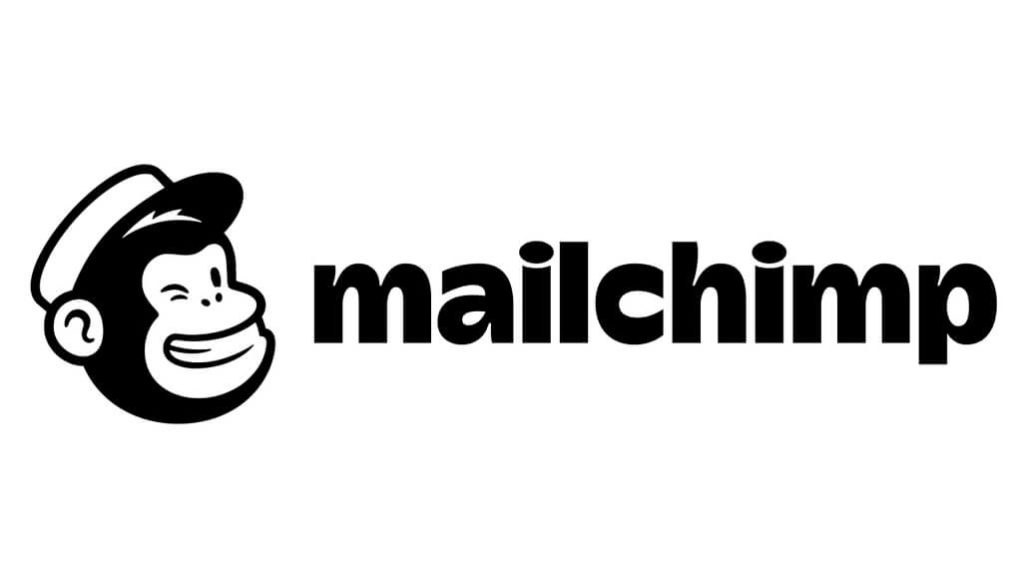
Mailchimp offers easy-to-use segmentation options, including conditional relationships. You can also create automated workflows using pre-built segments.
However, we found that you can’t view all your contacts on a single screen, as contacts are managed at the list level — a significant downside.
For those looking for advanced automation, Mailchimp may feel limited. It’s better suited for beginners starting with email marketing.
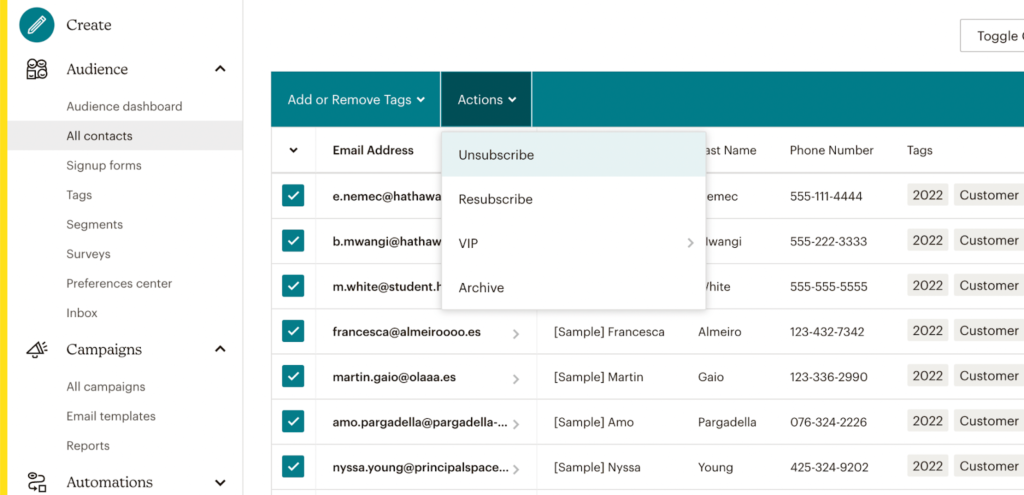
Key Features
- Multiple campaign types with easy personalization;
- Conditional relationships to create dynamic list segments;
- Segmentation based on demographic and behavioral data.
Pros & Cons
MailChimp has become exploitative with recent pricing updates. They constantly raise their prices, increasing your marketing costs. Here are the pros and cons of picking MailChimp:
| Pros | Cons |
| Quick and straightforward to set up and use | Lacks advanced automation features |
| Predictive personalization insights based on email list demography | Not great with managing email deliverability |
| Behavioral targeting for email campaigns | List-level contact management makes it hard to create advanced workflows for all subscribers. |
Pricing
Starts at $13 per month for up to 500 contacts.
#3. Constant Contact — Simple Email List Manager
Constant Contact is a simple direct mail list management software with all essential features.
Best for
- Online retailers;
- Creators & influencers;
- Non-profits.
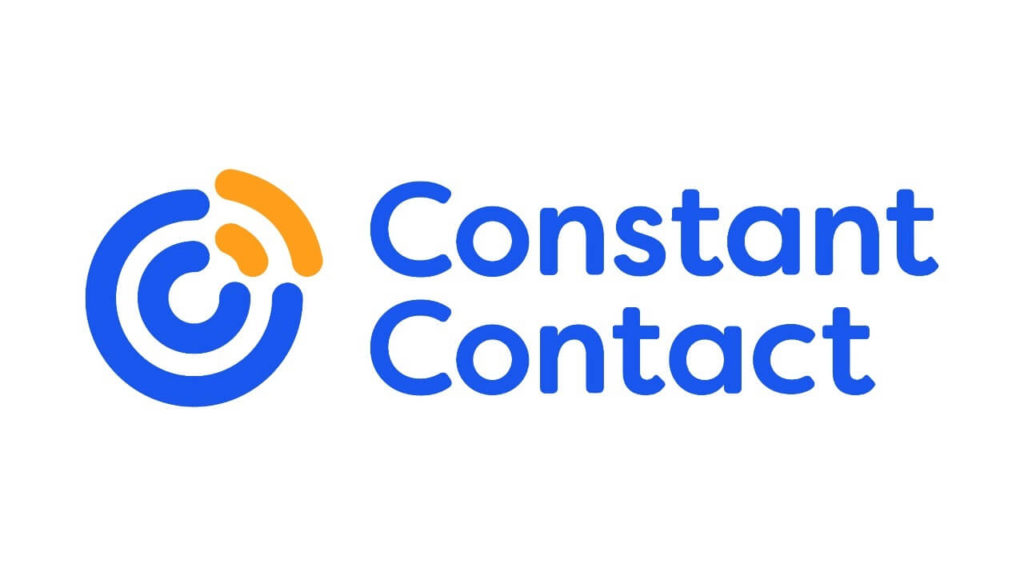
While Constant Contact focuses on beginners looking for simplicity, it still offers useful segmentation options based on user actions like open rates and clickthroughs. You can also segment by custom contact tags and profile details.
However, we feel Constant Contact’s segmentation features need a reinvention after iOS’ latest privacy updates, which limits activity tracking.
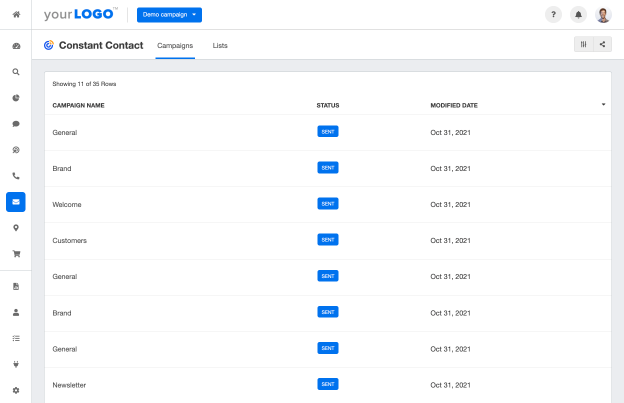
Key Features
- Email capture landing page builder;
- Segmentation based on last interaction, user activity, or tags;
- Contact list folders and segmentation features;
- Automation for welcome emails, lead nurturing, follow-ups, etc.
Pros & Cons
Constant Contact is a robust solution with a user-friendly interface. But if you are looking for advanced segmentation, look at other contact list management software on this list. Here are the pros and cons:
| Pros | Cons |
| Easy-to-use interface ideal for beginners and solopreneurs | Lack of advanced segmentation and grouping features |
| Massive library of customizable email templates for email marketing campaigns. | Clunky list management UI |
| Social media integration for omnichannel campaigns | Lack of reliable reporting features |
Pricing
- Free trial plan for up to 60 days to test the platform and send up to 100 emails;
- Paid plans start at $12/month for up to 500 contacts.
#4. Active Campaign — Comprehensive Email Marketing Service
Active Campaign is an email marketing and email list manager with comprehensive automation and list segmentation features.
Best for
- Content creators;
- Enterprise clients;
- Agencies.

ActiveCampaign has great segmentation features for sorting your email list. You can automate grouping based on user behavior. There’s also lead scoring and a built-in CRM feature to nurture leads and contacts efficiently.
Its social/ad account integration also helps bring your audience from social to the same dashboard for retargeting/nurturing.
Key Features
- Audience nurturing and segmentation features;
- Visual automation builder;
- Lead scoring;
- Social and ad account audiences;
- Dynamic content for personalization.
Pros & Cons
Active Campaign is a feature-rich solution, but the costs can be quite restrictive for many. Here are some more pros and cons:
| Pros | Cons |
| User-friendly interface | Steep learning curve |
| Great automation features | High cost of operations |
| Integrated CRM dashboard | Limited free trial |
Pricing
- 14-day free trial for testing the platform;
- Paid plans start at $15/month for up to 1,000 subscribers.
#5. OptinMonster — Great Email List Building Tools
OptinMonster is a subscriber management software for creating high-converting email capture forms and scheduling follow-up campaigns.
Best for
- Ecommerce stores;
- Websites with massive traffic;
- Personality-driven brands.

Design beautiful, mobile-friendly forms using its drag-and-drop builder, or choose from over 400 templates to set up forms that match your brand guidelines.
Show popups based on user behavior, ensuring each visitor sees relevant offers. Plus, it seamlessly integrates with top email marketing platforms, automatically adding new subscribers to your lists.
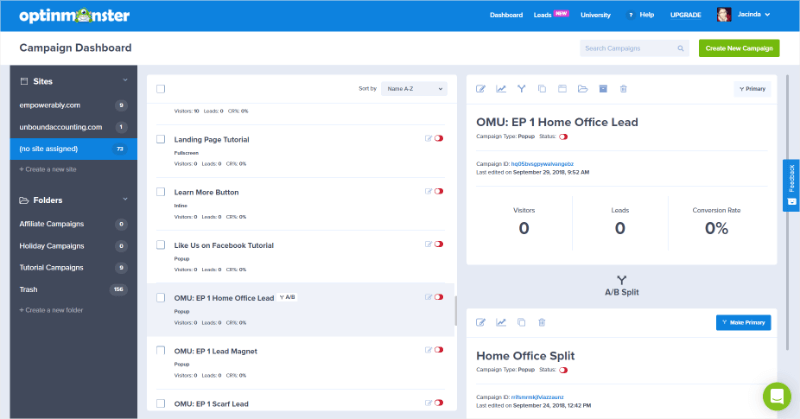
Key Features
- Drag-and-drop builder for website lead capture forms;
- Trigger popups and messages based on user actions;
- Test different form elements to optimize conversions;
- Segment your email list based on user behavior and demographics;
- Works with major email marketing services and website platforms.
Pros & Cons
OptinMonster is good at capturing email addresses but lacks advanced segmentation features and comprehensive email marketing capabilities. Here are some of the pros and cons of this tool:
| Pros | Cons |
| Drag-and-drop builder for email capture forms | Can be expensive for small businesses |
| Advanced targeting and personalization options | No email campaign management features |
| Seamless integration with email marketing services | Basic analytics dashboard with no deep insights |
Pricing
- Paid plans start at $6/month for one website and up to 2,500 page views;
- No free plan is mentioned on the website.
#6. HubSpot — Advanced Email List Management Software
HubSpot’s all-in-one CRM and marketing platform offers powerful features for organizing and managing your email lists.
Best for
- B2B startups;
- Marketing agencies;
- Mid-market corporates.

Target subscribers based on deal stage, contact details, or other advanced conditions. Or use its automated workflows for elaborate drip campaigns and lead nurturing sequences triggered by specific actions or stages in the customer journey.
With robust list management features, HubSpot is ideal for large enterprises looking for advanced control.
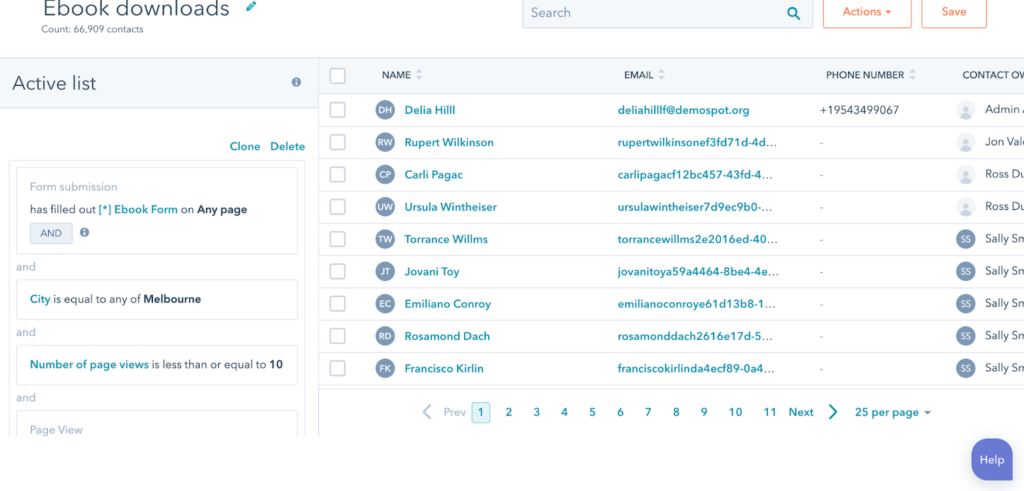
Key Features
- Email list management connected to a central CRM system;
- Automated segmentation and grouping of contacts;
- Multiple options to create dynamic email list groups and segments;
- Two-way data sync between apps.
Pros & Cons
HubSpot is a popular solution with advanced nurturing capabilities, but it has a very expensive starter plan. Here are some pros and cons:
| Pros | Cons |
| Advanced CRM system for complete transparency of lead stages | Steep learning curve |
| Conditional segmentation and personalization features | Expensive |
| Deep integration with all major marketing tools and platforms | No A/B testing on the basic package |
Pricing
- Paid plans start at $18/month for up to 1,000 marketing contacts;
- Free plan supports up to 2,000 monthly emails and offers a free CRM with feature restrictions.
#7. FluentCRM – Advanced Email List Management CRM for WordPress
FluentCRM is a marketing automation plugin specifically made for WordPress users. Due to the affordable pricing and WordPress-friendly nature, the plugin is the most popular in its category.
Best for
- Coaches and influencers;
- B2B SaaS companies;
- Large Ecommerce stores.

FluentCRM’s main advantage is its automatic integration with most WordPress plugins, making it easy to access customer, lead, and membership data.
It offers powerful list management tools, allowing you to segment contacts by purchases, enrollments, and more. Plus, its advanced filtering system helps you hyper-target contacts for email marketing and automation campaigns.

Key Features
- Store, manage, and automate email campaigns;
- Access detailed contact info like purchases and course progress;
- Set behavior-based triggers for automated emails;
- Segment contacts using any WordPress data;
- Integrates automatically with 35+ WordPress plugins.
Pros & Cons
| Pros | Cons |
| Deeply integrated with WordPress and WordPress plugins | Only for WordPress |
| Advanced filtering with data available on WP, FluentCRM, and WP plugins | |
| Activity-based email automation features |
Pricing
- FluentCRM prices start at $129/year.
#8. Listserv — Dedicated Solution for Email List Management
Listserv is a dedicated mailing list software for managing your existing email lists and newsletter subscribers.
Best for
- Newsletter creators;
- Local communities;
- Small businesses.
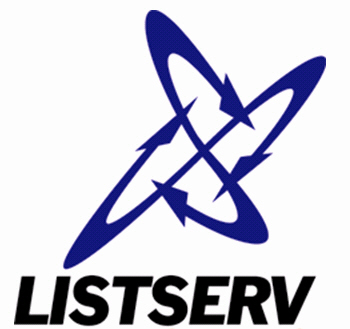
Dedicated to community building, Listserv management software helps you engage your subscribers across email groups, forums, newsletters, and other channels.
You can use it to create custom lists, segment users between different lists, and send personalized marketing emails or newsletters.
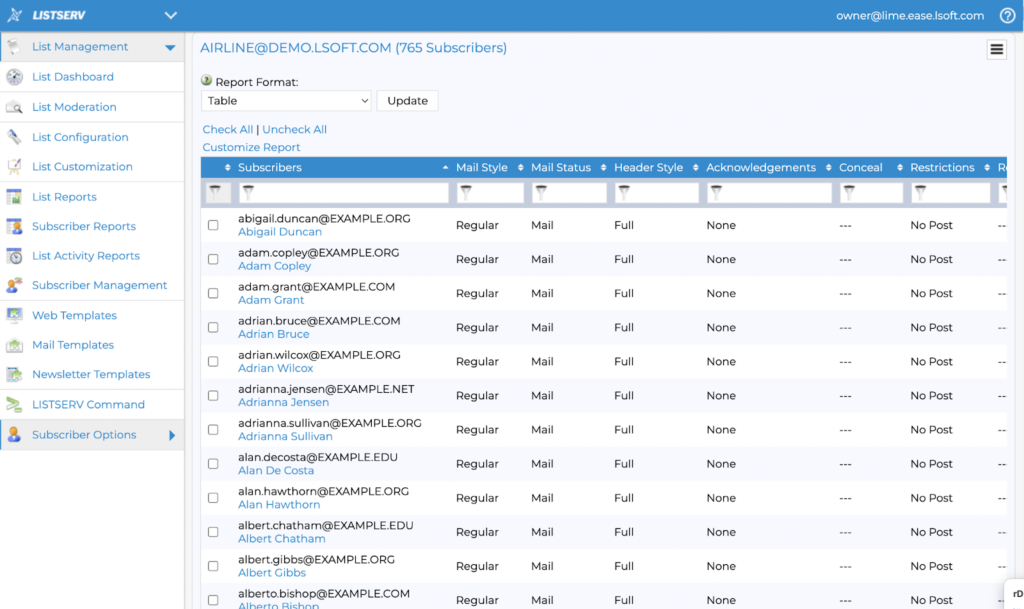
Key Features
- Supports public or private subscribers list creation;
- Moderator-based list management features;
- Sublists for advanced categorization and overlapping subscribers.
Pros & Cons
The list segmentation software is known for community-building features, but its clunky UI and obsolete features haven’t made it much popular. Here are the pros and cons of choosing Listserv:
| Pros | Cons |
| Exclusive features for businesses looking to build a community of users via newsletters, forums, or blogs | Outdated/obsolete propositions for advanced campaigns |
| List creation and admin wizard for automation of list management activities | Limited templates and email design features on lower packages |
Pricing
- No free plan or trial option;
- Paid plans start at $2875 for a lifetime license.
#9. Brevo — Refined Email List Management Tool
Brevo is an all-in-one email list management and CRM platform for storing unlimited contacts while keeping your lists clean and organized.
Best for
- Ecommerce platforms;
- Small businesses;
- Personal branding experts.

With Brevo, you can automatically segment contacts by behavior, interests, and other attributes, making campaign personalization effortless. It supports multiple channels like email, SMS, and WhatsApp, allowing you to run seamless omnichannel campaigns.
In-built list cleanup tools like engagement filters for email lists help you maintain list hygiene.
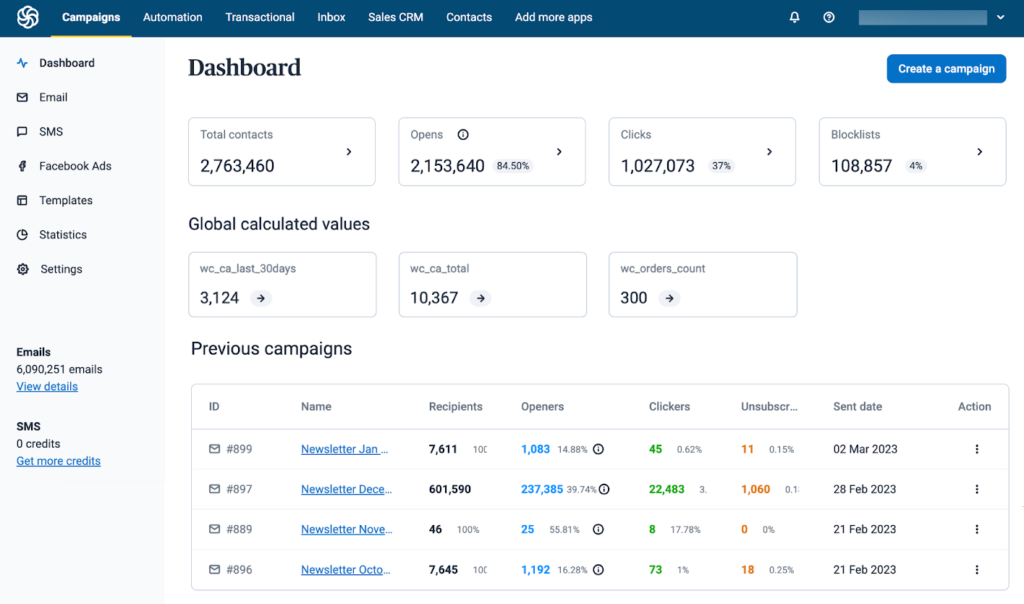
Key Features
- Automated segmentation based on different attributes;
- List management dashboard for tracking leads through the customer journey;
- Contact list folders to manage separate lists;
- Import your customer list data from different platforms.
Pros & Cons
Brevo is a powerful omnichannel marketing tool, but before you pick it, here are some pros and cons to weigh in your decision:
| Pros | Cons |
| Extensive multi-channel capabilities | Steep learning curve |
| Powerful personalization and segmentation features | Costly for small businesses |
| Great email deliverability | Overwhelming for first-time users looking for just email marketing and list management features. |
Pricing
- Free plan is available but limited to sending 300 emails per day;
- Paid plan starts at $25 per month for sending up to 25,000 emails per month.
Want to crush your business goals? Check out these 9 best marketing platforms for specific business goal to find the perfect tool for your needs.
#10. phpList — Best Open Source Email Marketing Software
phpList is an open-source email marketing platform for businesses who want complete campaign control.
Best for
- Developers;
- SaaS startups;
- Tech companies.

The mailing list manager is an open-source alternative for efficiently segmenting subscribers. Use custom attributes to group your mailing list and send the right message at the right time.
phpList offers deep subscriber insights, including history, demographics, and engagement.
Key Features
- Personalized autoresponder campaigns;
- Blacklist and sender score optimization;
- Real-time data tracking;
- Flexible pricing model.
Pros & Cons
phpList is an open-source solution that charges only for the service used. Here are some pros and cons:
| Pros | Cons |
| Starter plan for $1 for up to 9000 emails | Steep learning curve |
| Superior deliverability metrics | No landing page builder |
| Reliable segmentation features | Confusing UI |
Pricing
- Forever-free plan to try out the service before using;
- Paid plan starts at $8/month for up to 500 subscribers.
#11. SendGrid — Software for List Management Solutions
SendGrid is perfect for marketers focused on email deliverability and in-depth analytics. Its powerful API makes integrating with other tools in your marketing stack easy.
Best for
- Event management companies;
- Educational institutions;
- Nonprofits.

While it excels in deliverability, SendGrid isn’t a complete solution for those who need robust list management and segmentation tools.
When it comes to managing email lists, SendGrid falls short. It lacks essential segmentation features, like segmenting based on user behavior or activity, limiting your ability to create advanced flows or personalized campaigns.
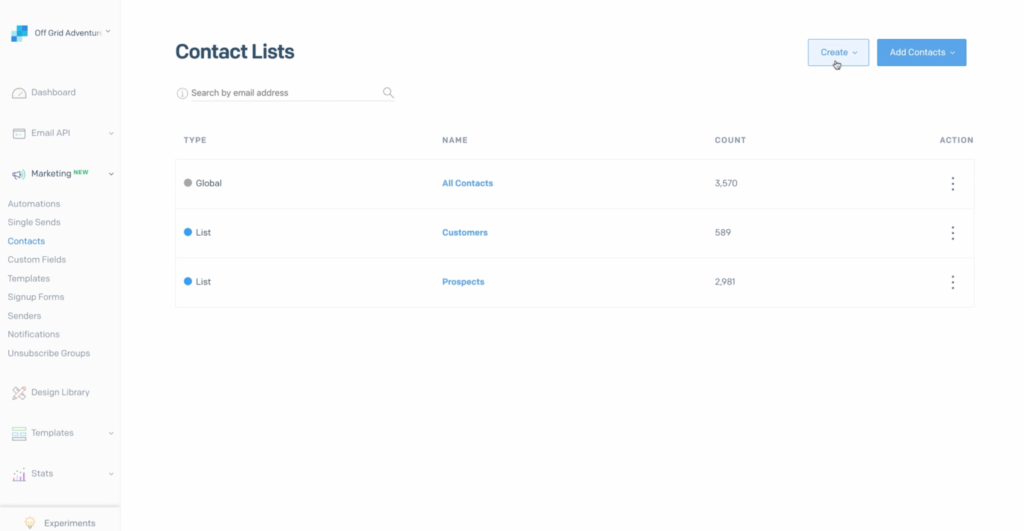
Key Features
- Pre-built autoresponder sequences;
- Excellent analytics features;
- Email verification tool;
- Set up preference-based email campaigns.
Pros & Cons
SendGrid is a great solution for anyone serious about email deliverability, but when it comes to email list management, it might not be your best bet. Here’s a brief list of pros and cons:
| Pros | Cons |
| Detailed analytics dashboard to track campaign performance | Lack of basic options like behavioral segmentation for list management and personalization |
| Failproof email deliverability standards | Only basic autoresponders and automation are available |
| Great onboarding experience | No live chat support for free plans |
Pricing
- Free plan for sending 6,000 emails/month for up to 2,000 subscribers;
- Paid plans start at $15/month for up to 2000 subscribers and 15,000 emails.
Also read: Sendgrid Alternatives with Free Competitors Included
Email Marketing Strategy for Mailing List Management
A well-managed mailing list is crucial for email marketing success. Here are some tips to improve the quality of your email list:
- Segment your email list. Group subscribers based on demographics, behavior, and preferences. Remove invalid email addresses and inactive subscribers to maintain list hygiene;
- Use double opt-in. Implement sign-up forms with a confirmation step to ensure only high-intent subscribers enter your list;
- Maintain compliance with regulations. Adhere to laws like GDPR and CAN-SPAM to protect user privacy and avoid legal issues;
- Tailor content to your target audience. Personalize content based on preferences to resonate with specific segments of your list;
- Clean your list regularly. Review your list and remove inactive/invalid subscribers periodically for a healthy email list;
- Use automation workflows for follow-ups. Set up automated sequences to nurture leads and re-engage inactive subscribers.
How to Select the Right Software for Mailing Lists?
Choosing the right mailing list software is crucial for proper email list management and successful email marketing campaigns.
Consider the following before going with a solution:
- Ease of use. Ensure the software has an intuitive interface and is easy to navigate, even for beginners;
- Features. Look for essential features like segmentation, automation, personalization, analytics, and compliance tools;
- Integration. Check if it integrates smoothly with your existing email marketing tools and platforms, such as CRM, ecommerce, and social media;
- Scalability. Choose a solution that can grow with your business, handling an increasing number of subscribers and emails without increasing costs exorbitantly;
- Customer support. Opt for software that offers fast and reliable customer support, including tutorials, live chat, and help desks;
- Pricing. Evaluate the pricing plans to ensure they fit your budget while offering the best value for the features provided;
- Deliverability rates. Research the software’s deliverability rates to ensure your emails land in subscribers’ inboxes.
- Trial period. Take advantage of free trials or demos to test the software before committing to a purchase.
The best way to test an email service provider is to pick one with a zero-restriction free plan that lets you test all the features.
Also read:

